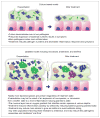Understanding persistent bacterial lung infections: clinical implications informed by the biology of the microbiota and biofilms
- PMID: 27004018
- PMCID: PMC4798234
- DOI: 10.1097/CPM.0000000000000108
Understanding persistent bacterial lung infections: clinical implications informed by the biology of the microbiota and biofilms
Abstract
The infections found in chronic obstructive pulmonary disease, cystic fibrosis, and bronchiectasis share a number of clinical similarities, the most striking of which is bacterial persistence despite the use of antibiotics. These infections have been clinically described using culture-based methods usually performed on sputum samples, and treatment has been directed towards the bacteria found in this manner. Unfortunately the clinical response to antibiotics is frequently not predictable based on these cultures, and the role of these cultured organisms in disease progression has been debated. The past 20 years have seen a revolution in the techniques used to describe bacterial populations and their growth patterns. These techniques have revealed these persistent lung infections are vastly more complicated than described by traditional, and still widely relied upon, sputum cultures. A better understanding of the initiation and evolution of these infections, and better clinical tools to describe them, will dramatically alter the way patients are cared for. While clinical tests to more accurately describe these infections are not yet available, the better appreciation of these infections afforded by current science should enlighten practitioners as to the care of their patients with these diseases.
Keywords: Chronic obstructive pulmonary disease; bronchiectasis; cystic fibrosis; microbiota; sputum culture.
Conflict of interest statement
The authors declare no conflicts of interests related to the contents of this article.
Figures



Similar articles
-
Assessing effects of inhaled antibiotics in adults with non-cystic fibrosis bronchiectasis--experiences from recent clinical trials.Expert Rev Respir Med. 2018 Sep;12(9):769-782. doi: 10.1080/17476348.2018.1503540. Epub 2018 Aug 3. Expert Rev Respir Med. 2018. PMID: 30025482 Review.
-
A novel microbiota stratification system predicts future exacerbations in bronchiectasis.Ann Am Thorac Soc. 2014 May;11(4):496-503. doi: 10.1513/AnnalsATS.201310-335OC. Ann Am Thorac Soc. 2014. PMID: 24592925
-
Lung Microbiota Changes Associated with Chronic Pseudomonas aeruginosa Lung Infection and the Impact of Intravenous Colistimethate Sodium.PLoS One. 2015 Nov 6;10(11):e0142097. doi: 10.1371/journal.pone.0142097. eCollection 2015. PLoS One. 2015. PMID: 26544950 Free PMC article.
-
Sputum DNA sequencing in cystic fibrosis: non-invasive access to the lung microbiome and to pathogen details.Microbiome. 2017 Feb 10;5(1):20. doi: 10.1186/s40168-017-0234-1. Microbiome. 2017. PMID: 28187782 Free PMC article.
-
The effect of N-acetylcysteine on biofilms: Implications for the treatment of respiratory tract infections.Respir Med. 2016 Aug;117:190-7. doi: 10.1016/j.rmed.2016.06.015. Epub 2016 Jun 16. Respir Med. 2016. PMID: 27492531 Review.
Cited by
-
Therapeutic stem cell-derived alveolar-like macrophages display bactericidal effects and resolve Pseudomonas aeruginosa-induced lung injury.J Cell Mol Med. 2022 May;26(10):3046-3059. doi: 10.1111/jcmm.17324. Epub 2022 Apr 20. J Cell Mol Med. 2022. PMID: 35441437 Free PMC article.
-
Therapeutic Approaches for Chronic Obstructive Pulmonary Disease (COPD) Exacerbations.Pathogens. 2022 Dec 10;11(12):1513. doi: 10.3390/pathogens11121513. Pathogens. 2022. PMID: 36558847 Free PMC article. Review.
-
Pseudomonas aeruginosa Quorum-Sensing and Type VI Secretion System Can Direct Interspecific Coexistence During Evolution.Front Microbiol. 2018 Oct 11;9:2287. doi: 10.3389/fmicb.2018.02287. eCollection 2018. Front Microbiol. 2018. PMID: 30364310 Free PMC article.
-
The Role of Non-Typeable Haemophilus influenzae Biofilms in Chronic Obstructive Pulmonary Disease.Front Cell Infect Microbiol. 2021 Aug 4;11:720742. doi: 10.3389/fcimb.2021.720742. eCollection 2021. Front Cell Infect Microbiol. 2021. PMID: 34422683 Free PMC article. Review.
-
Benzimidazolium salts prevent and disrupt methicillin-resistant Staphylococcus aureus biofilms.RSC Adv. 2020 Mar 4;10(16):9420-9430. doi: 10.1039/d0ra00738b. eCollection 2020 Mar 2. RSC Adv. 2020. PMID: 35497239 Free PMC article.
References
-
- Whitters D, Stockley R. Immunity and bacterial colonisation in bronchiectasis. Thorax. 2012;67(11):1006–1013. - PubMed
-
- Vollenweider DJ, Jarrett H, Steurer-Stey CA, Garcia-Aymerich J, Puhan MA. Antibiotics for exacerbations of chronic obstructive pulmonary disease. Cochrane Database Syst Rev. 2012;12:CD010257. - PubMed
-
- Saiman L, Siegel J. Infection control recommendations for patients with cystic fibrosis: microbiology, important pathogens, and infection control practices to prevent patient-to-patient transmission. Infect Control Hosp Epidemiol. 2003;24(5 Suppl):S6–52. - PubMed
-
- Rosenfeld M, Emerson J, Williams-Warren J, et al. Defining a pulmonary exacerbation in cystic fibrosis. J Pediatr. 2001;139(3):359–365. - PubMed
-
- Burge S, Wedzicha JA. COPD exacerbations: definitions and classifications. Eur Respir J Suppl. 2003;41:46s–53s. - PubMed
Grants and funding
LinkOut - more resources
Full Text Sources
Other Literature Sources
Miscellaneous
